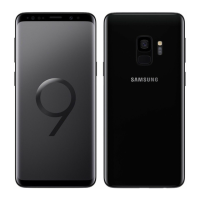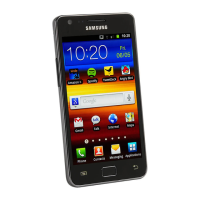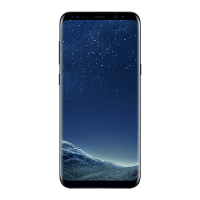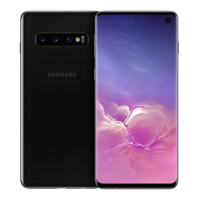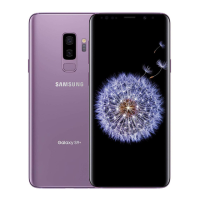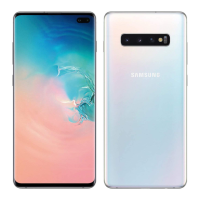Do you have a question about the Samsung Galaxy S7 and is the answer not in the manual?
Explains the basics of using this guide and the new phone.
Guides on finding help on the phone and accessing Sprint support.
Illustrates the phone’s primary parts, key functions, and layout.
Instructions for charging the phone's battery using AC adapter or PC.
Information on the SIM card and guidelines for handling and inserting it.
Tips to prevent damage from water and dust exposure.
Information on using, inserting, unmounting, and formatting the SD card.
Instructions on how to power the phone on and off.
Explains basic and advanced touch gestures like tap, swipe, and drag.
Steps to activate the phone and complete initial setup screens.
Overview of basic phone operations, home screen, and apps list.
Accessing phone settings and understanding screen orientation modes.
Controlling screen rotation and capturing screenshots.
Launching applications and managing them via the Apps list.
Turning the screen off/on and unlocking the device.
Downloading and applying software updates for the phone.
Creating, signing in, and managing Google accounts for app access.
Understanding and managing Factory Reset Protection (FRP).
Accessing and using the Play Store to find, install, and manage apps.
Managing apps via refunds, updates, and uninstallation.
Fundamentals of the home screen, its layout, and extended pages.
Understanding status bar icons and using the notification panel.
Using multiple applications simultaneously in a split-screen view.
Personalizing the home screen with shortcuts, widgets, folders, and wallpapers.
Using the phone app for calls, voicemail, and in-call options.
How to place emergency calls, including 9-1-1.
Procedures for answering incoming calls and managing ringtones.
Understanding in-call screen options like add call, speaker, and Bluetooth.
Placing calls directly from saved contacts.
Placing calls to recent incoming, outgoing, or missed numbers.
Setting up and using voicemail and visual voicemail features.
Features like Wi-Fi Calling, Caller ID blocking, and Call Waiting.
Configuring voicemail options and other phone application settings.
Storing, adding, viewing, editing, deleting, and organizing contacts.
Sharing information via text, multimedia, and email.
Using Google's Gmail service for managing emails.
Setting up and managing email accounts, including Exchange ActiveSync.
Basics of using data services, including 4G LTE and network options.
Understanding and updating your Sprint user name for data services.
Using the browser, bookmarks, history, and tabs.
Using Chrome for browsing, bringing tabs and data from computer.
Using Hangouts, Instagram, and Messenger for communication.
Activating Sprint Worldwide service before using global roaming.
Information on the SIM card for roaming and how to insert it.
Setting up global roaming options and network modes for travel.
Selecting network modes and carriers for overseas use.
Making international calls and using Sprint voicemail abroad.
Setting up voicemail access and retrieving messages internationally.
Connecting to email and web browsing internationally via data roaming.
Troubleshooting and contacting Sprint for international service issues.
Using a USB cable to transfer files between phone and computer.
Connecting to Wi-Fi networks for internet access.
Turning the phone into a Wi-Fi hotspot to share mobile data.
Connecting wirelessly to Bluetooth devices like headsets.
Sharing the phone's internet connection via USB or Bluetooth.
Using the camera to take and share pictures and videos.
Understanding the Play Music player and creating custom playlists.
Managing health with S Health and safety advice before exercising.
Accessing Sprint account info and viewing/uploading YouTube videos.
Basic settings for Wi-Fi, Bluetooth, mobile networks, and hotspot.
Enabling and configuring location services for apps like Google Maps.
Additional connectivity options like printing, MirrorLink, and VPN.
Settings for sounds, display, gestures, apps, and device maintenance.
Configuring notification options for apps and advanced settings.
Adjusting wallpaper, brightness, screen timeout, and other display items.
Personalization settings including wallpaper, themes, and icons.
Setting screen lock methods, customizing lock screen, and security features.
Features for users with vision, hearing, or dexterity impairments.
Adding and managing email, social, and cloud accounts.
Core system settings like language, input, date/time, and reset options.
Optimizing battery, storage, memory, and device performance.
Accessing help menus, troubleshooting, and contacting support.
Troubleshooting, account info, warranty, and customer service contact.
Explains the basics of using this guide and the new phone.
Guides on finding help on the phone and accessing Sprint support.
Illustrates the phone’s primary parts, key functions, and layout.
Instructions for charging the phone's battery using AC adapter or PC.
Information on the SIM card and guidelines for handling and inserting it.
Tips to prevent damage from water and dust exposure.
Information on using, inserting, unmounting, and formatting the SD card.
Instructions on how to power the phone on and off.
Explains basic and advanced touch gestures like tap, swipe, and drag.
Steps to activate the phone and complete initial setup screens.
Overview of basic phone operations, home screen, and apps list.
Accessing phone settings and understanding screen orientation modes.
Controlling screen rotation and capturing screenshots.
Launching applications and managing them via the Apps list.
Turning the screen off/on and unlocking the device.
Downloading and applying software updates for the phone.
Creating, signing in, and managing Google accounts for app access.
Understanding and managing Factory Reset Protection (FRP).
Accessing and using the Play Store to find, install, and manage apps.
Managing apps via refunds, updates, and uninstallation.
Fundamentals of the home screen, its layout, and extended pages.
Understanding status bar icons and using the notification panel.
Using multiple applications simultaneously in a split-screen view.
Personalizing the home screen with shortcuts, widgets, folders, and wallpapers.
Using the phone app for calls, voicemail, and in-call options.
How to place emergency calls, including 9-1-1.
Procedures for answering incoming calls and managing ringtones.
Understanding in-call screen options like add call, speaker, and Bluetooth.
Placing calls directly from saved contacts.
Placing calls to recent incoming, outgoing, or missed numbers.
Setting up and using voicemail and visual voicemail features.
Features like Wi-Fi Calling, Caller ID blocking, and Call Waiting.
Configuring voicemail options and other phone application settings.
Storing, adding, viewing, editing, deleting, and organizing contacts.
Sharing information via text, multimedia, and email.
Using Google's Gmail service for managing emails.
Setting up and managing email accounts, including Exchange ActiveSync.
Basics of using data services, including 4G LTE and network options.
Understanding and updating your Sprint user name for data services.
Using the browser, bookmarks, history, and tabs.
Using Chrome for browsing, bringing tabs and data from computer.
Using Hangouts, Instagram, and Messenger for communication.
Activating Sprint Worldwide service before using global roaming.
Information on the SIM card for roaming and how to insert it.
Setting up global roaming options and network modes for travel.
Selecting network modes and carriers for overseas use.
Making international calls and using Sprint voicemail abroad.
Setting up voicemail access and retrieving messages internationally.
Connecting to email and web browsing internationally via data roaming.
Troubleshooting and contacting Sprint for international service issues.
Using a USB cable to transfer files between phone and computer.
Connecting to Wi-Fi networks for internet access.
Turning the phone into a Wi-Fi hotspot to share mobile data.
Connecting wirelessly to Bluetooth devices like headsets.
Sharing the phone's internet connection via USB or Bluetooth.
Using the camera to take and share pictures and videos.
Understanding the Play Music player and creating custom playlists.
Managing health with S Health and safety advice before exercising.
Accessing Sprint account info and viewing/uploading YouTube videos.
Basic settings for Wi-Fi, Bluetooth, mobile networks, and hotspot.
Enabling and configuring location services for apps like Google Maps.
Additional connectivity options like printing, MirrorLink, and VPN.
Settings for sounds, display, gestures, apps, and device maintenance.
Configuring notification options for apps and advanced settings.
Adjusting wallpaper, brightness, screen timeout, and other display items.
Personalization settings including wallpaper, themes, and icons.
Setting screen lock methods, customizing lock screen, and security features.
Features for users with vision, hearing, or dexterity impairments.
Adding and managing email, social, and cloud accounts.
Core system settings like language, input, date/time, and reset options.
Optimizing battery, storage, memory, and device performance.
Accessing help menus, troubleshooting, and contacting support.
Troubleshooting, account info, warranty, and customer service contact.
| Position location | Yes |
|---|---|
| Screen shape | Flat |
| Pixel density | 577 ppi |
| Second display | No |
| Display diagonal | 5.1 \ |
| Touch technology | Multi-touch |
| Touchscreen type | Capacitive |
| Native aspect ratio | 16:9 |
| Display number of colors | 16.78 million colors |
| Processor cores | 4 |
| Processor family | Samsung Exynos |
| Processor frequency | 2.3 GHz |
| Coprocessor frequency | 1.6 GHz |
| Supported video modes | 2160p |
| Audio formats supported | 3GA, AAC, AMR, AWB, FLAC, IMY, M4A, MID, MP3, MXMF, OGA, OGG, OTA, RTTTL, RTX, WAV, WMA, XMF |
| Video formats supported | 3G2, 3GP, ASF, AVI, FLV, M4V, MKV, MP4, WEBM, WMV |
| Multimedia Messaging Service (MMS) | Multimedia Messaging Service (MMS) is a standard way to send messages that include multimedia content to and from a mobile phone over a cellular network |
| Themes | Wallpapers |
| Personalization | Icons, Menu, Themes |
| Personal info management (PIM) | Alarm clock, Calculator, Calendar, Events reminder, Notes, To-do list |
| RAM type | LPDDR4 |
| User memory | 24.5 GB |
| RAM capacity | 4 GB |
| Compatible memory cards | MicroSD (TransFlash), MicroSDHC, MicroSDXC |
| Maximum memory card size | 200 GB |
| Internal storage capacity | 32 GB |
| Flash type | LED |
| Sensor type | CMOS |
| Rear camera type | Single camera |
| Maximum frame rate | 120 fps |
| Optical sensor size | 1/2.6 \ |
| Video recording modes | 1080p, 2160p, 720p |
| Rear camera aperture number | 1.7 |
| Resolution at capture speed | 1280x720@120fps, 1920x1080@60fps, 3840x2160@30fps |
| Video capture resolution (max) | 3840 x 2160 pixels |
| Rear camera resolution (numeric) | 12 MP |
| Front camera resolution (numeric) | 5 MP |
| Talk time (3G) | 22 h |
| Battery capacity | 3000 mAh |
| Standby time (3G) | - h |
| Browsing time (3G) | 11 h |
| Browsing time (4G) | 13 h |
| Browsing time (Wi-Fi) | 15 h |
| Continuous audio playback time | 45 h |
| Continuous audio playback time (display off) | 62 h |
| 4G standard | LTE |
| 2G standards | GSM |
| 3G standards | HSPA+, UMTS, WCDMA |
| SIM card type | NanoSIM |
| Wi-Fi standards | 802.11a, Wi-Fi 5 (802.11ac), 802.11b, 802.11g, Wi-Fi 4 (802.11n) |
| Bluetooth version | 4.2 |
| 3G bands supported | 850, 900, 1900, 2100 MHz |
| 4G bands supported | 700, 800, 850, 900, 1800, 1900, 2100, 2300, 2500, 2600 MHz |
| Bluetooth profiles | A2DP, AVRCP, HFP, HID, HOGP, HSP, MAP, OPP, PAN, PBAP |
| SIM card capability | Single SIM |
| 2G bands (primary SIM) | 850, 900, 1800, 1900 MHz |
| Mobile network generation | 4G |
| Subscription type | No subscription |
| USB version | 2.0 |
| USB connector type | Micro-USB |
| HDMI ports quantity | 0 |
| Headphone connectivity | 3.5 mm |
| Platform | Android |
| Google applications | Google Maps, Google Play, YouTube |
| App distribution platform | Google Play |
| Operating system installed | Android 6.0 |
| Body SAR (EU) | 1.48 W/kg |
| Head SAR (EU) | 0.406 W/kg |
| Extremities SAR (EU) | 2.57 W/kg |
| Form factor | Bar |
| Product color | Pink gold |
| Protection features | Dust resistant, Water resistant |
| International Protection (IP) code | IP68 |
| Cables included | USB |
| Built-in sensors details | Hall, HR, RGB Light |
| Depth | 7.9 mm |
|---|---|
| Width | 69.6 mm |
| Height | 142.4 mm |
| Weight | 152 g |




